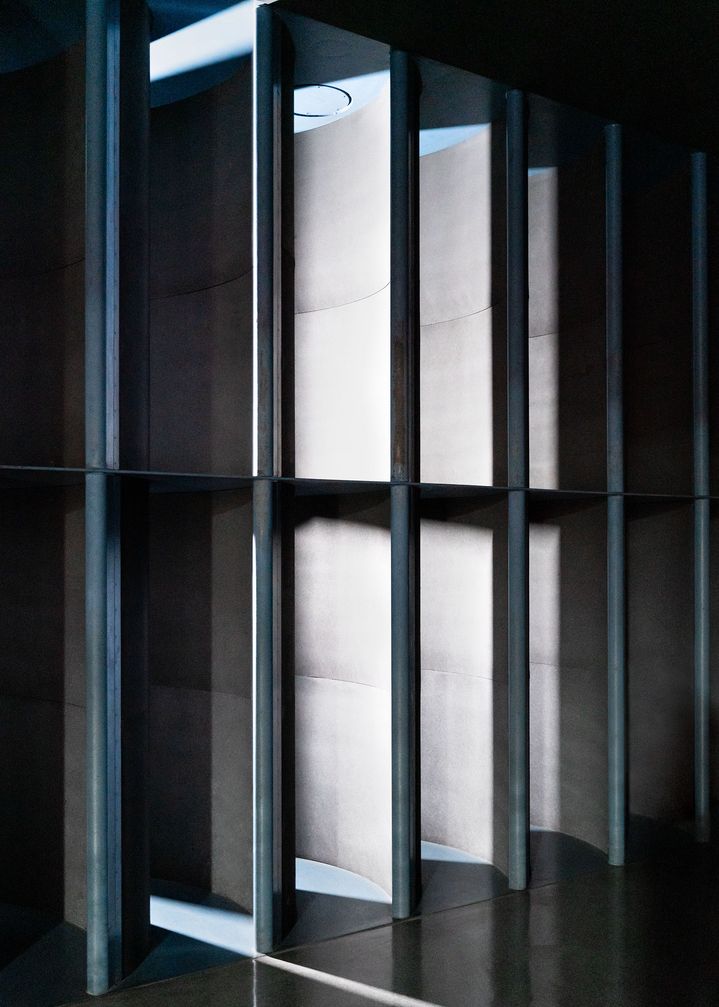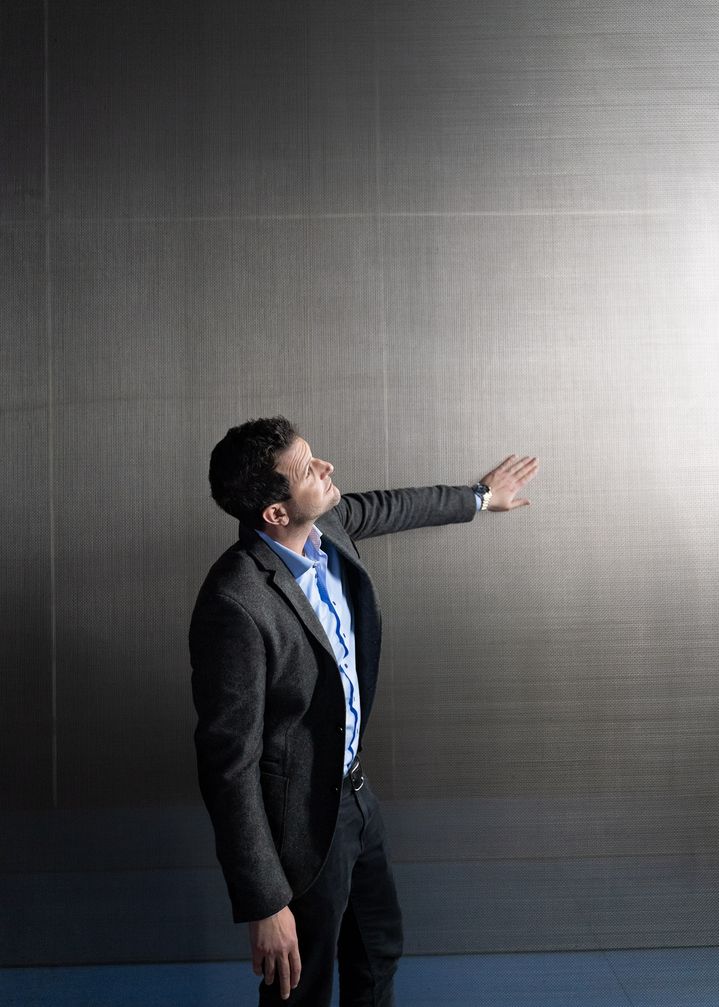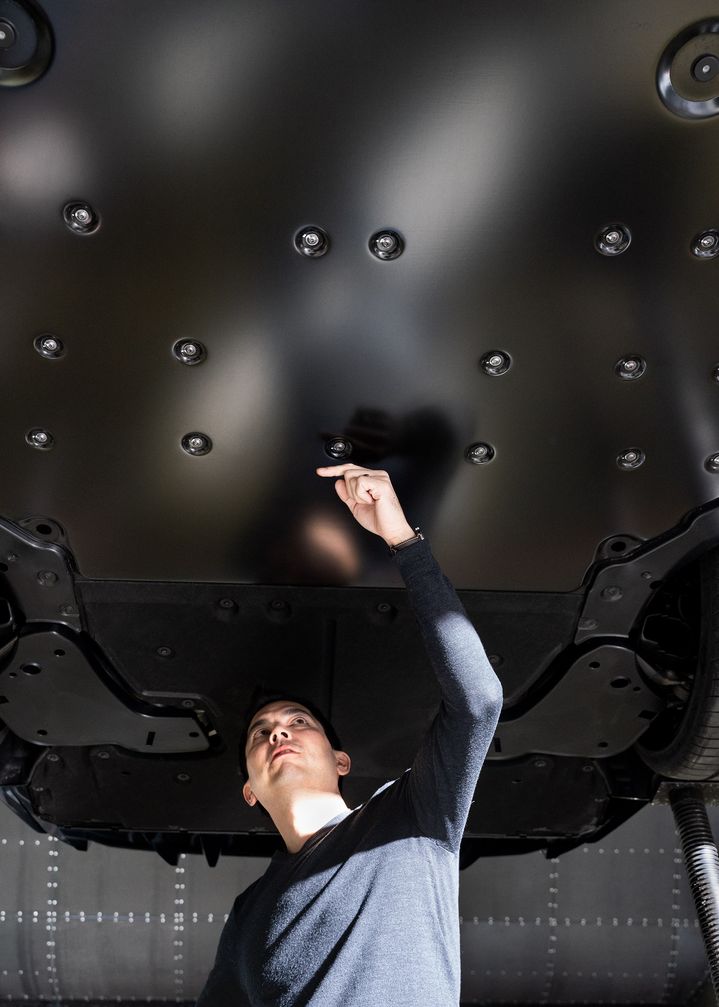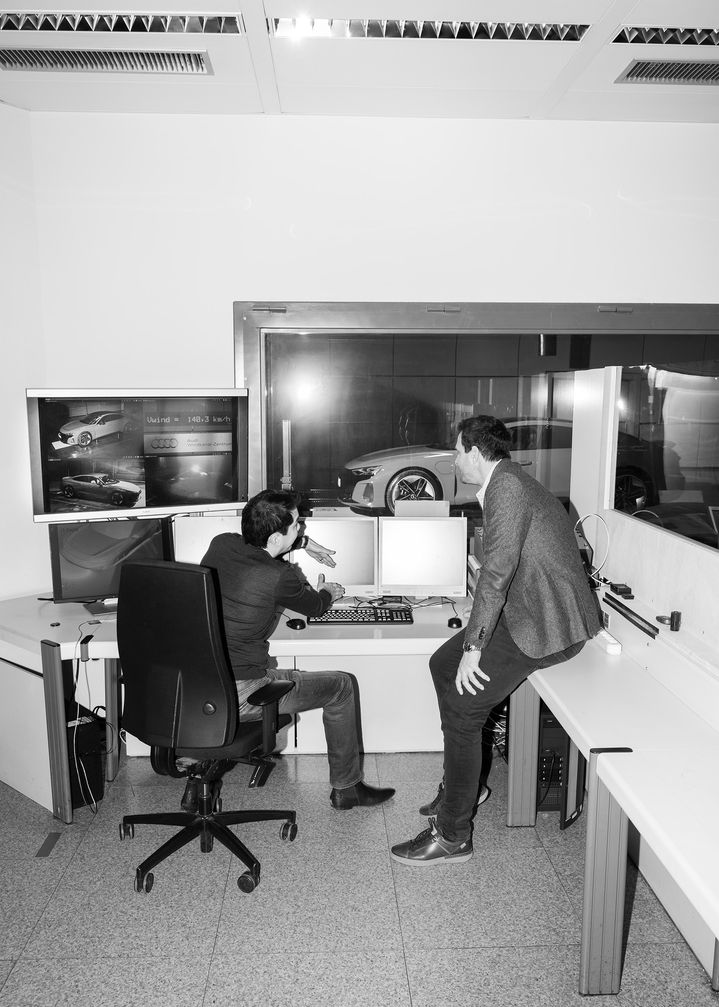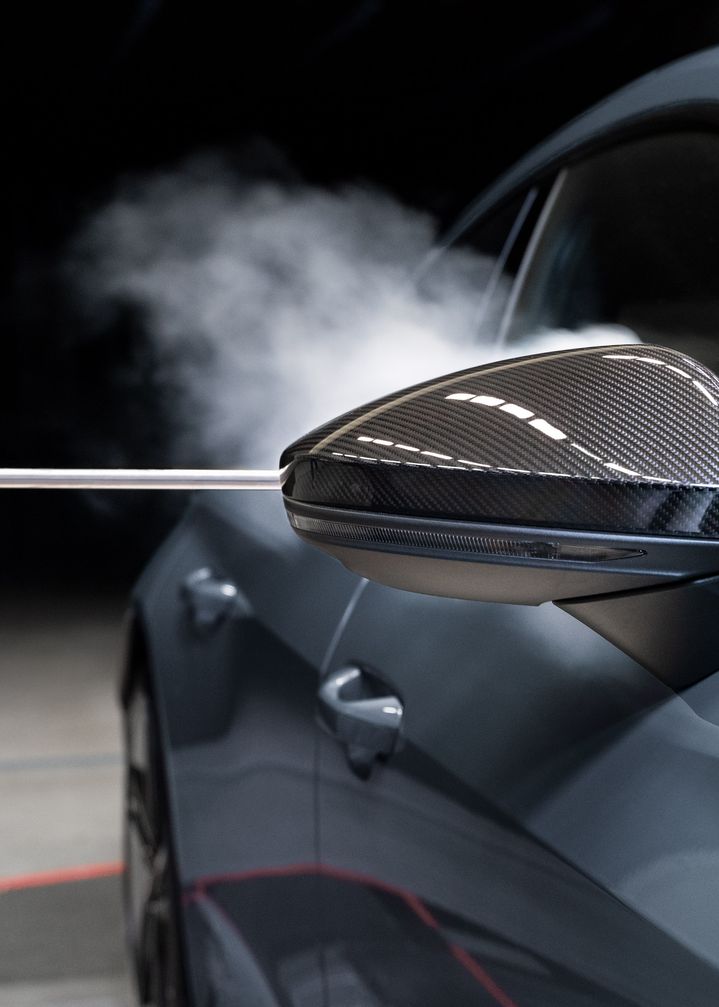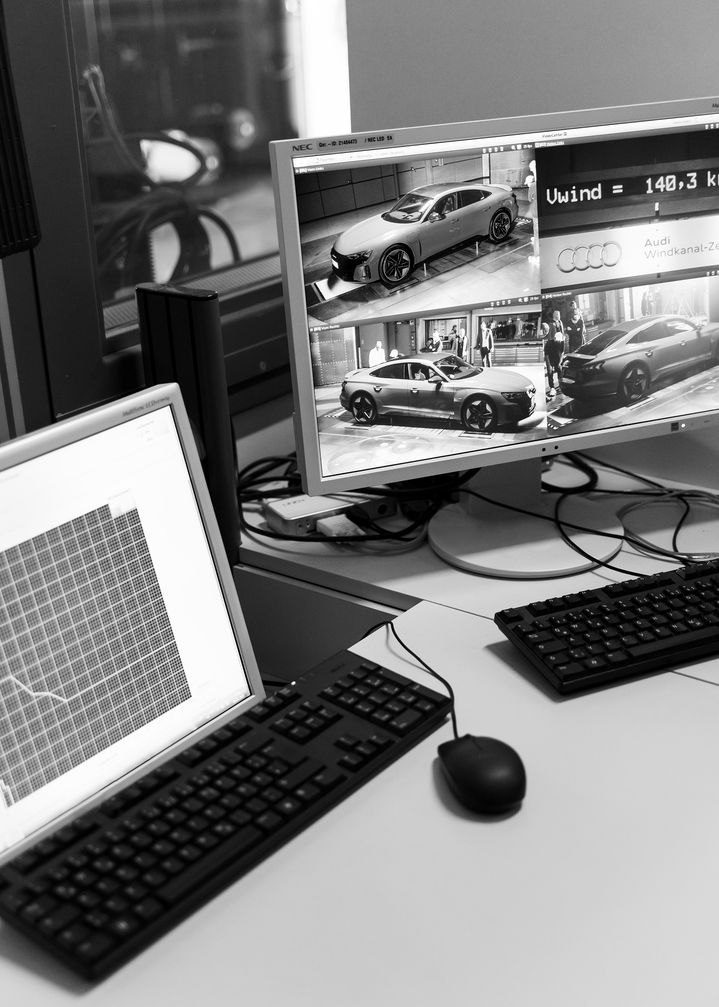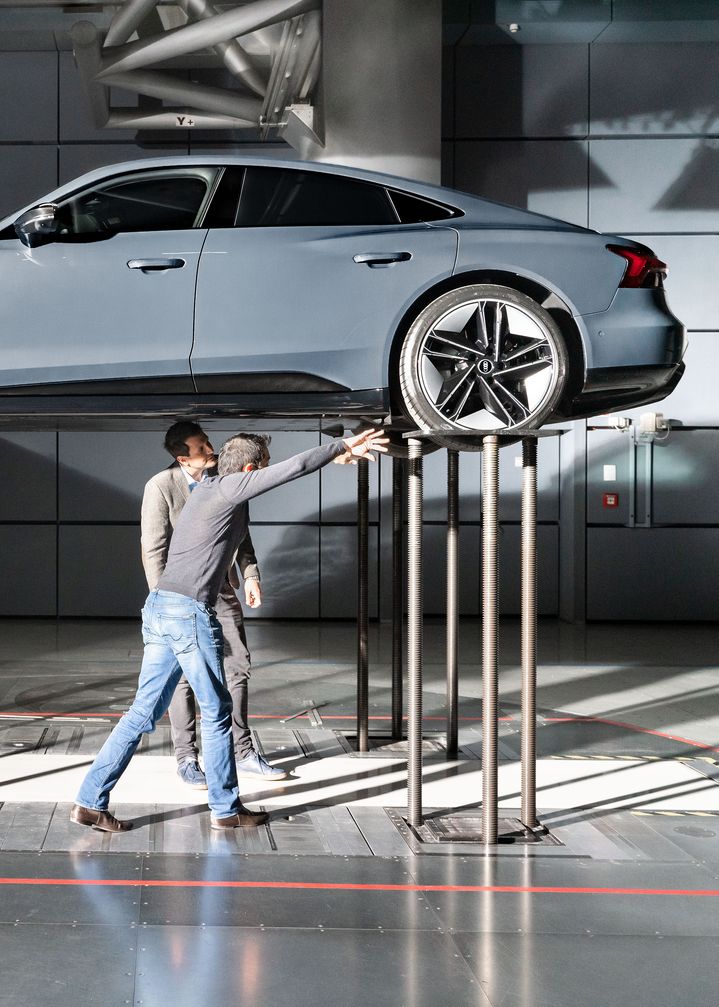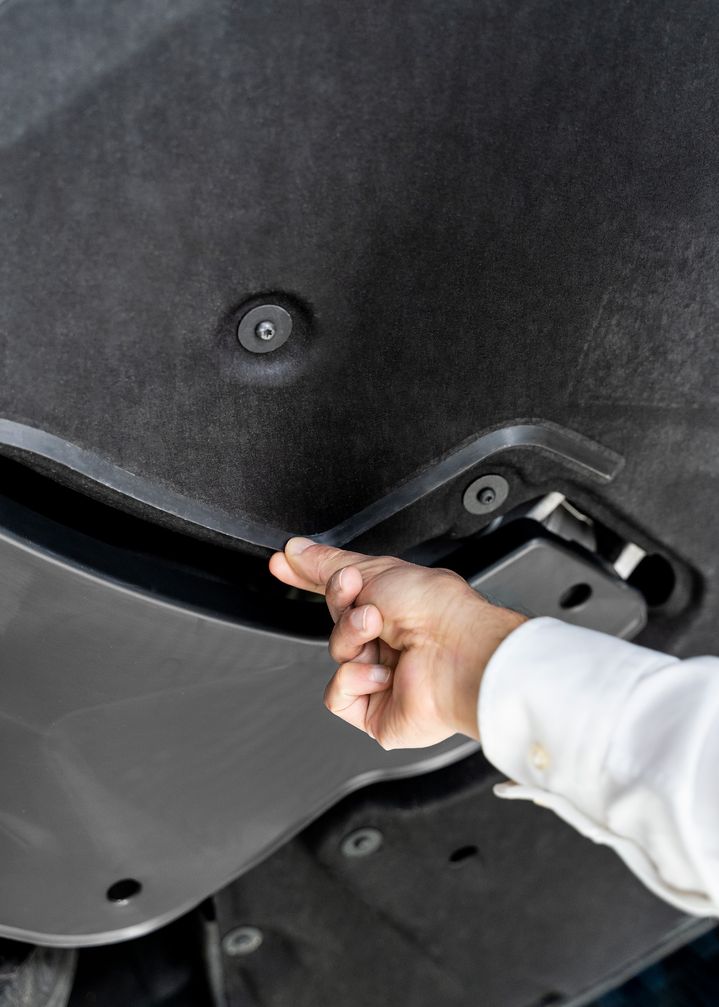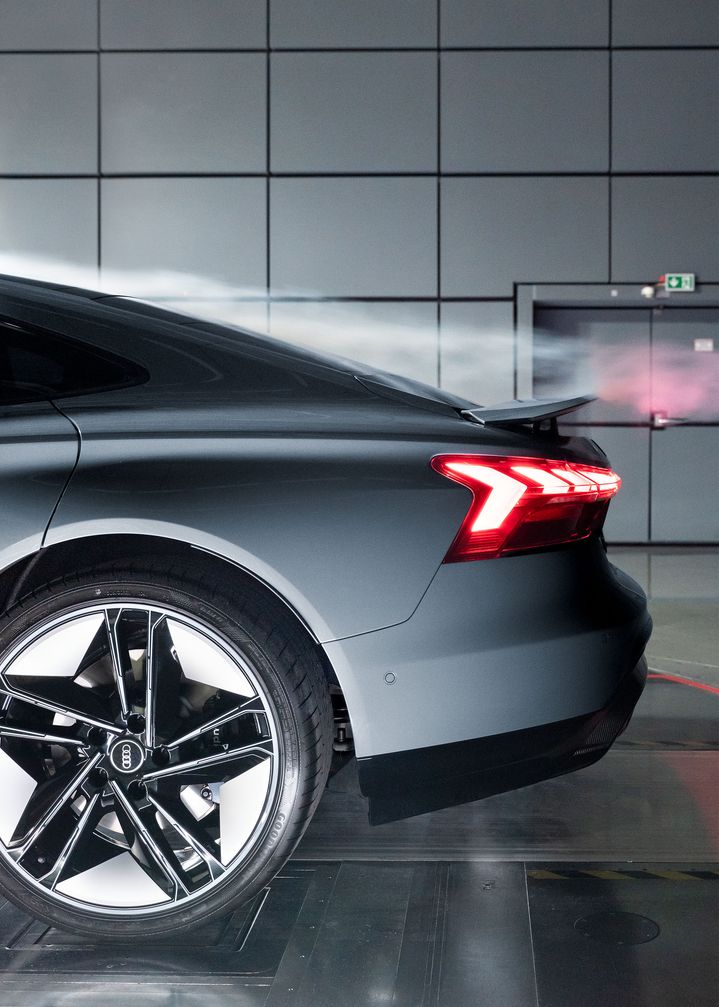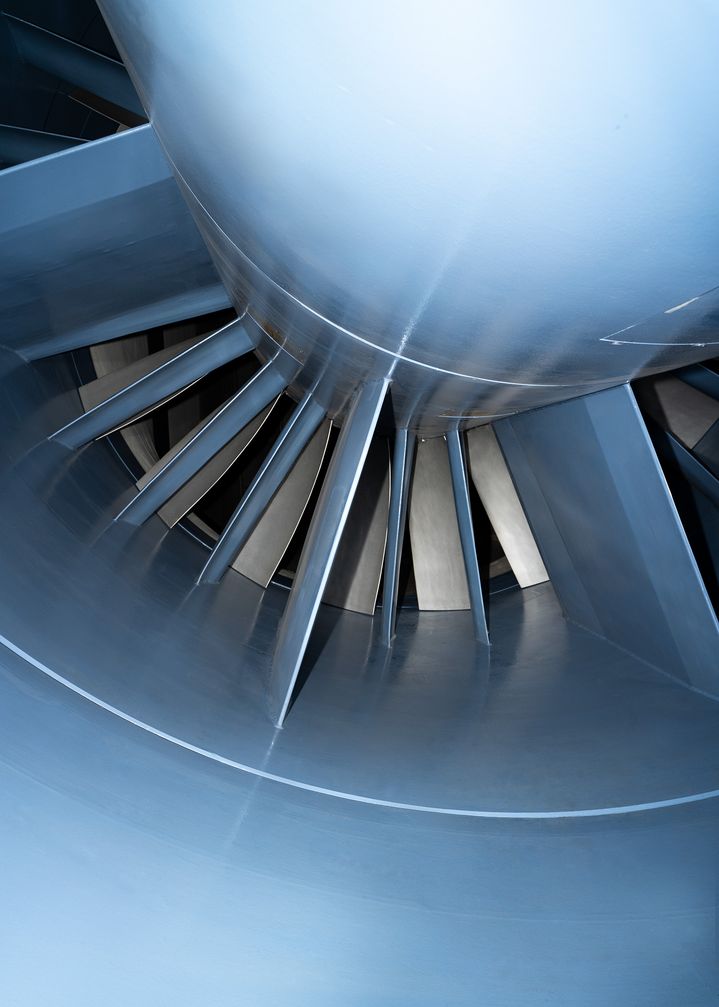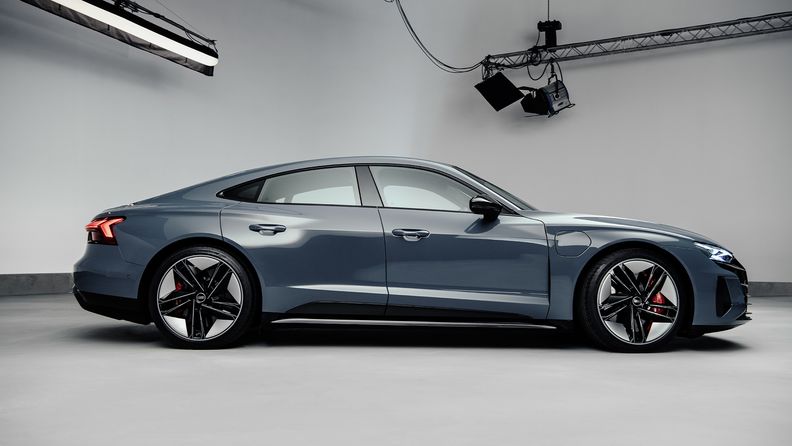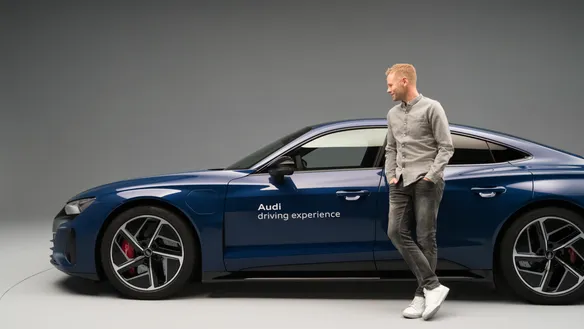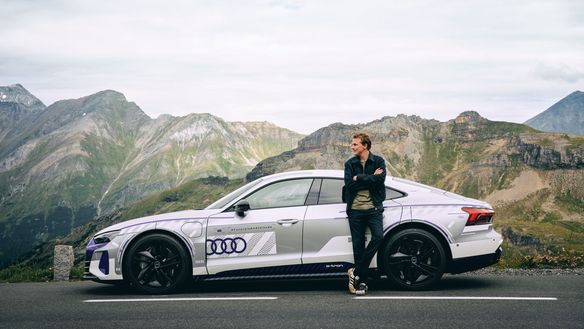Detective work in the wind tunnel
Audi RS e-tron GT: Power consumption (combined) in kWh/100 km: 21.1–18.4CO₂ emissions (combined) in g/km: 0CO₂ emission class: A
Stated specifications apply only in Germany and are not applicable in other regions.
Audi RS e-tron GT: Power consumption (combined) in kWh/100 km: 21.1–18.4CO₂ emissions (combined) in g/km: 0CO₂ emission class: A
Stated specifications apply only in Germany and are not applicable in other regions.
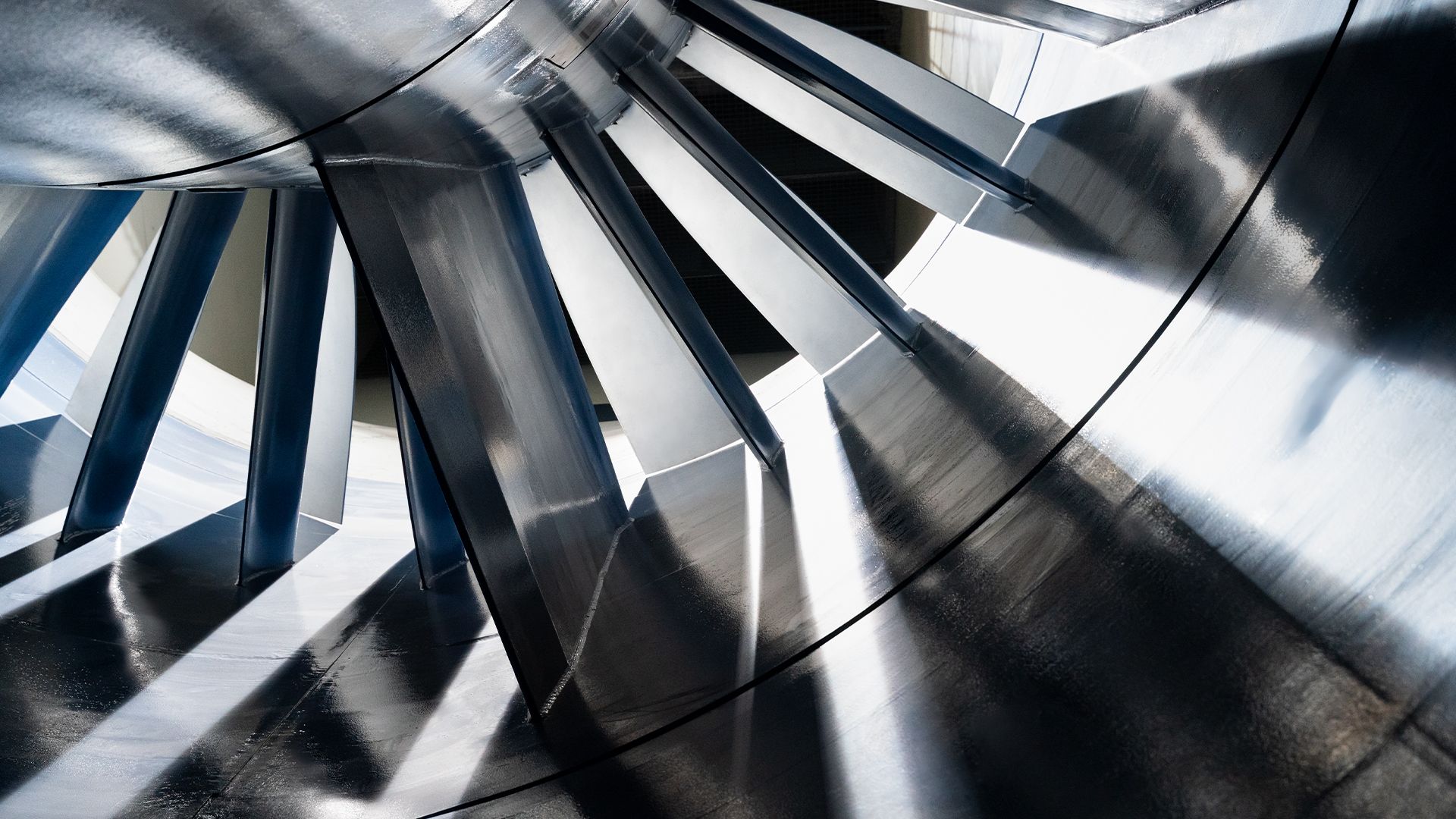
The first thing you notice when looking at the fan in the Audi aeroacoustic wind tunnel is the gap between each of the tips of the 20 blades on the wind tunnel rotor and the concrete shroud. A couple of perplexing centimeters. Is this an inefficient lack of precision? Dr. Moni Islam, Head of Development Aerodynamics & Aeroacoustics at Audi, provides reassurance: “When the fan runs at maximum power of 2.720 kW, the centrifugal force stretches the aluminum-coated blades, almost completely closing this gap. After all, we’re generating the forces here that result in a wind speed of up to 300 km/h in the test section.”

Then everyone has to leave the wind tunnel. The 20 blades of the five-meter-wide fan slowly start to turn. The swirling airflow is first stabilised by the 27 guide vanes of the stator downstream of the fan. The air then turns two corners , where it is distributed evenly by specially designed turning vanes on its way to the test section. Grids downstream of the vanes break up the large-scale the turbulence, which is unavoidable in the vicinity of the corners and the fan. The air then passes through a honeycomb layer to straighten the flow and into a large settling chamber downstream. It is then accelerated through the nozzle with a contraction ratio of 5.5 before reaching the Audi RS e-tron GT in the plenum the main chamber at exactly the desired speed.
Audi RS e-tron GT: Power consumption (combined) in kWh/100 km: 21.1–18.4CO₂ emissions (combined) in g/km: 0CO₂ emission class: A
Stated specifications apply only in Germany and are not applicable in other regions.
Audi RS e-tron GT: Power consumption (combined) in kWh/100 km: 21.1–18.4CO₂ emissions (combined) in g/km: 0CO₂ emission class: A
Stated specifications apply only in Germany and are not applicable in other regions.
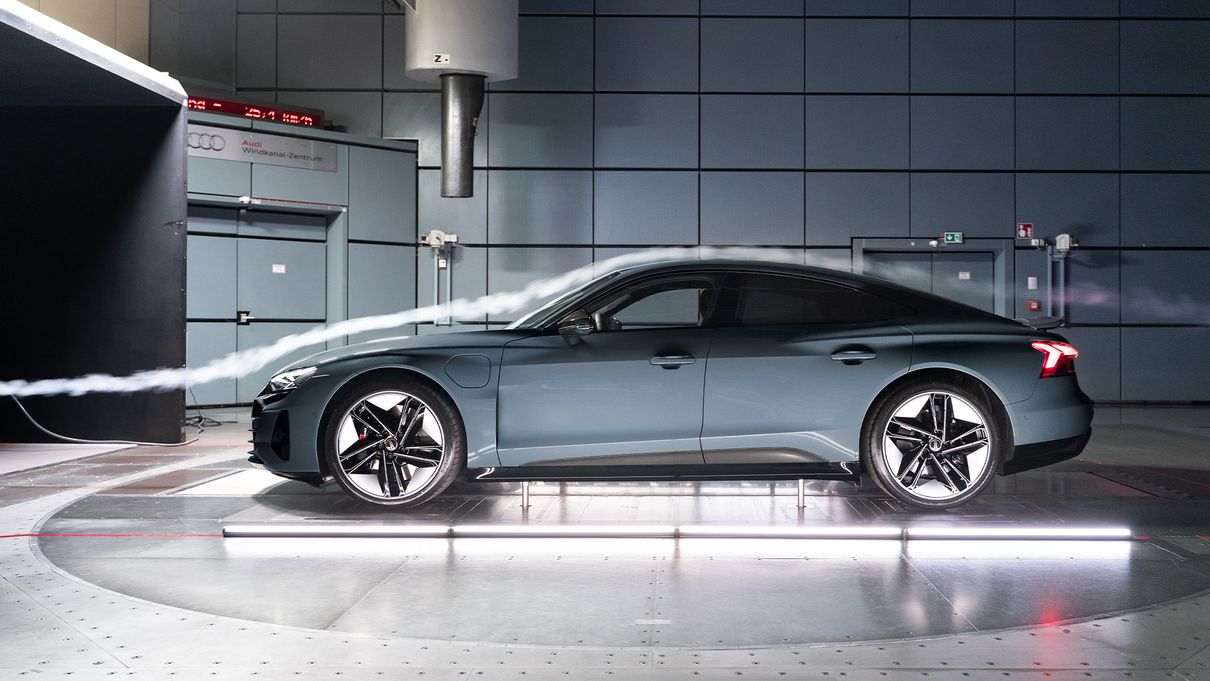
German model shown.
German model shown.
The vehicle stands on a precision balance which measures the aerodynamic forces on the vehicle. Its wheels stand on four small belts which ensure that they rotate at wind speed. A wide belt under the car simulates the movement of the road relative to the vehicle at all running speeds. In addition, high-precision adjustable perforated plates in the floor in front of the vehicle extract part of the airflow—the so-called boundary layer—before it reaches the car. Aerodynamicists call this design “full ground simulation”: This guarantees realistic airflow around the vehicle.
Once the air has passed the Audi RS e-tron GT, the expanded jet from the plenum is captured by the downstream collector and directed back into the wind tunnel circuit and to the fan. This completes the cycle of air through the Audi aeroacoustic wind tunnel. And if you think it sounds complicated, that’s because it truly is.
Audi RS e-tron GT: Power consumption (combined) in kWh/100 km: 21.1–18.4CO₂ emissions (combined) in g/km: 0CO₂ emission class: A
Stated specifications apply only in Germany and are not applicable in other regions.
Audi RS e-tron GT: Power consumption (combined) in kWh/100 km: 21.1–18.4CO₂ emissions (combined) in g/km: 0CO₂ emission class: A
Stated specifications apply only in Germany and are not applicable in other regions.
Going to great lengths to achieve the perfect airflow
Dr. Kentaro Zens, the development engineer responsible for the aerodynamics and aeroacoustics of the Audi RS e-tron GT, says: “On the road, the vehicle moves through the air. Here in the wind tunnel, it’s the exact opposite: The vehicle is stationary and we channel the air around it as evenly as possible. We go to great lengths to achieve perfect airflow. Only when the airflow interacts accurately with the vehicle are we able to obtain accurate measurement results that we can rely on.”
Zens sits at his workstation next to the control panels with which the operators regulate the wind tunnel. He can read all the relevant data on screens: What is the drag coefficient, how high is the front-axle lift, how high is the rear-axle lift, at what wind speed and what belt speed?
Standing next to him is Thomas Redenbach, Head of Aerodynamics & Aeroacoustics Development – Vehicle Projects: “When the Wind-Tunnel Center went into operation, it was the first automotive wind tunnel worldwide to combine ground simulation of real-world road conditions for aerodynamics with such extremely quiet aeroacoustic functionality.”
Today, the wind tunnel runs up to six days a week from 7:00 a.m. to 10:30 p.m. in two shifts. And when the Worldwide Harmonized Light-Duty Vehicles Test Procedure (WLTP) certification was introduced by legislators, its capacity was utilized to the full. Moni Islam says: “The complexity of this wind tunnel called for the full commitment and technical expertise of our sister department, which has been operating it for us every day for many years. At the time, our colleagues from wind-tunnel operations provided us developers with 23 hours of testing time per day, as we are required to submit certified wind-tunnel data to legislators as proof of the WLTP values.”
Audi RS e-tron GT: Power consumption (combined) in kWh/100 km: 21.1–18.4CO₂ emissions (combined) in g/km: 0CO₂ emission class: A
Stated specifications apply only in Germany and are not applicable in other regions.
Audi RS e-tron GT: Power consumption (combined) in kWh/100 km: 21.1–18.4CO₂ emissions (combined) in g/km: 0CO₂ emission class: A
Stated specifications apply only in Germany and are not applicable in other regions.
“
Every count by which we can improve the drag coefficient increases the vehicle’s driving range.”
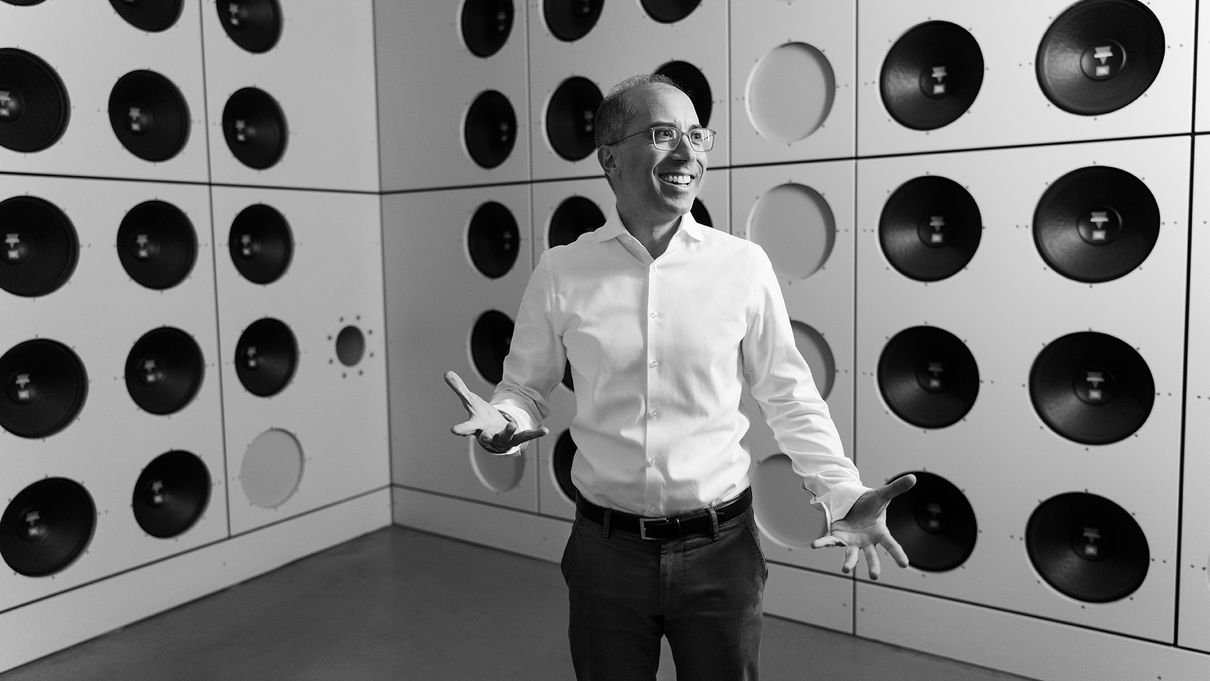
Simulation cannot replace the wind tunnel
Nevertheless, computer simulations are also playing an increasingly important role in aerodynamic development. Computational Fluid Dynamics (CFD) simulation reproduces airflow on the computer to enable analysis and visualisation of flow patterns. So why the time-consuming and expensive work in the wind tunnel? Thomas Redenbach: “The wind tunnel is our everyday tool and also enables us to validate the results from the simulation. We want to keep developing the simulations and, in order to ensure they are valid and accurate, we have to check the calculations against the test results.”
Yet computer simulations are getting better and better and becoming more and more important. Kentaro Zens says: “With the Audi RS e-tron GT, we did an exceptionally large amount of simulation work—over nine million CPU-hours. I spent 150 hours in the wind tunnel with the vehicle, which isn’t very much at all. By way of comparison, it was 600 hours for the Audi R8.” This indicates not only the quality of the Audi RS e-tron GT design but also that the development process was significantly shorter—a path Audi is aiming to take also with future models.
Moni Islam adds: “The wind tunnel and CFD are two complementary tools for the aerodynamicist. The wind tunnel is very accurate and quick, enabling us to work highly efficiently in the dynamic development process. Simulation provides us with an incredible amount of information, but requires effort in terms of preparation of the models and analysis of the results. With only one of these two tools, state-of-the-art aerodynamic development would not be possible.”
Audi RS e-tron GT: Power consumption (combined) in kWh/100 km: 21.1–18.4CO₂ emissions (combined) in g/km: 0CO₂ emission class: A
Stated specifications apply only in Germany and are not applicable in other regions.
Audi RS e-tron GT: Power consumption (combined) in kWh/100 km: 21.1–18.4CO₂ emissions (combined) in g/km: 0CO₂ emission class: A
Stated specifications apply only in Germany and are not applicable in other regions.
“
We invest an enormous amount of time in the last 20 percent of the aerodynamics optimisation.”
Leveraging potential in terms of range
For electric vehicles like the Audi RS e-tron GT, the full package offers benefits in terms of aerodynamics (the closed underbody being just one example of where this applies). However the challenges facing the 31-strong aerodynamic vehicle development staff in Moni Islam’s department are growing. He defines their aim as follows: “Every count by which we can improve the drag coefficient increases the driving range.”
Aerodynamicists identify this potential in the vehicle through simulation results that indicate sensitivities: If I change the geometry slightly at point X of the shape, how much does that affect the airflow? And then begins what Islam describes thus: “Aerodynamics is also meticulous detective work because you can’t see the air. You have to try to narrow down the problem using an analytical approach based on the values delivered by the balance in the wind tunnel.”
To achieve this, the engineers also work with various add-on parts generated with rapid-prototyping technology. Initially, CAD designs are created to define the geometries of the components—for example, an air intake on the front apron. The colleagues from model management then convert the desired variants, of which there may be several, into a test component using this advanced technology. The different variants of the components are subsequently tested in sequence on the vehicle model. The measurements provide drag and lift coefficients. These results are then selectively compared with the CFD simulations of exactly the same configuration to ensure valid simulation results.
Audi RS e-tron GT: Power consumption (combined) in kWh/100 km: 21.1–18.4CO₂ emissions (combined) in g/km: 0CO₂ emission class: A
Stated specifications apply only in Germany and are not applicable in other regions.
Audi RS e-tron GT: Power consumption (combined) in kWh/100 km: 21.1–18.4CO₂ emissions (combined) in g/km: 0CO₂ emission class: A
Stated specifications apply only in Germany and are not applicable in other regions.
Detective work for every drag count
“You can develop 80 percent of a vehicle’s aerodynamics in 20 percent of the time. But we invest an enormous amount of time in the last 20 percent of the aerodynamics—teasing out the drag counts in a host of tiny optimisation steps,” says Thomas Redenbach, describing the detective work in the wind tunnel. “It takes this high level of dedication and attention to detail to produce top-quality results.”
So what was the most difficult detail in terms of airflow in this Gran Turismo for the aerodynamics experts responsible for the Audi RS e-tron GT? Kentaro Zens thinks for a while. “The front apron with its four interconnected ducting components. The air flows into the intakes, the shutter inside closes—and that’s when the problem starts. The air can escape all over the place and you don’t want that. Keeping the airflow under control here and fine-tuning it precisely is critical. It’s a huge team effort as the colleagues from vehicle safety, parts engineering, production and assembly all have to work with me.”
Zens also makes specific reference to the design of the so-called air curtains in interaction with the wheel arch: “We had close coordination with the Audi designers on a weekly basis. This resulted in an optimal aerodynamic transition from the front end to the side around the air curtain that also fits seamlessly into the overall design as a coherent theme. Everything about the Audi RS e-tron GT has a function and a purpose. That’s authentic functionality, which is something I really like about the vehicle.”
Audi RS e-tron GT: Power consumption (combined) in kWh/100 km: 21.1–18.4CO₂ emissions (combined) in g/km: 0CO₂ emission class: A
Stated specifications apply only in Germany and are not applicable in other regions.
Audi RS e-tron GT: Power consumption (combined) in kWh/100 km: 21.1–18.4CO₂ emissions (combined) in g/km: 0CO₂ emission class: A
Stated specifications apply only in Germany and are not applicable in other regions.
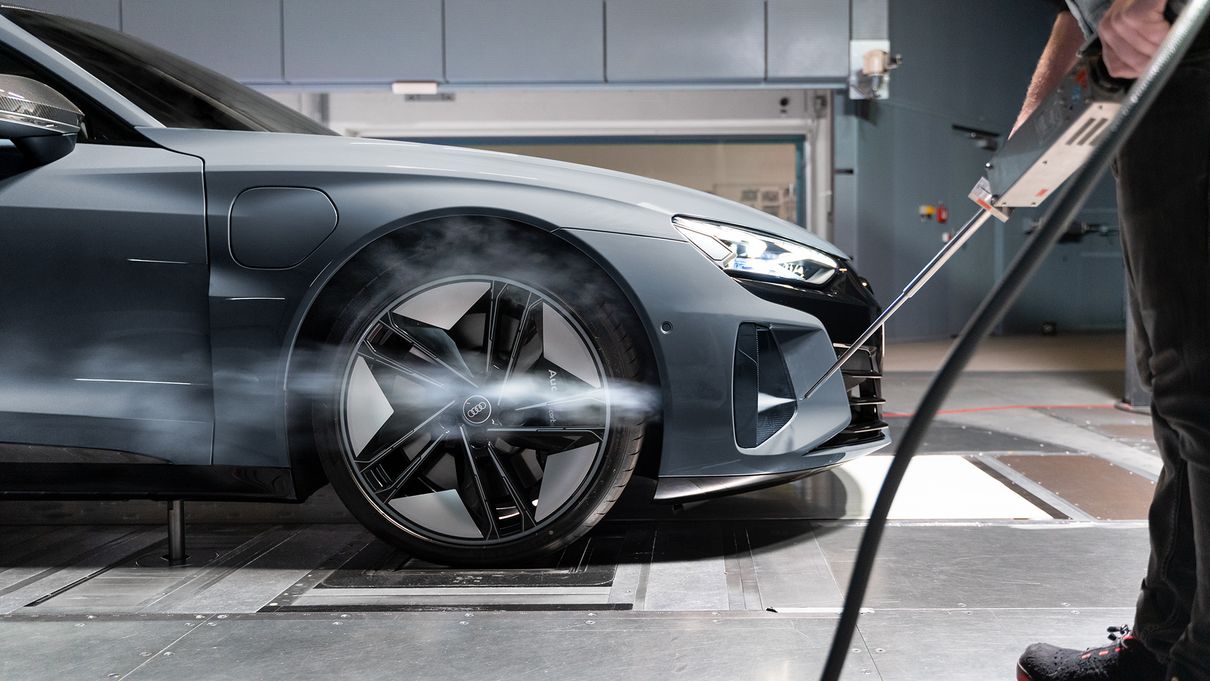
German model shown.
German model shown.
“
The aim of aerodynamics is to facilitate design.”
Zens also tested the positioning of the rear spoiler millimeter by millimeter in the wind tunnel to determine the optimum. Another example is also close to his heart: the sharp edge integrated into the taillight. “There are complex vortices at the rear of the Audi RS e-tron GT, in particular due to its pronounced three-dimensional shape. Guiding the airflow cleanly around this is a challenge. In the simulation, we saw that there was still room for improvement around the taillight.”
Fortunately, César Muntada, Head of Light Design at Audi, was also present in the wind tunnel during this test session. He quickly modeled a slight outward curve into an indentation in the taillight on the clay model, which now appears in exactly the same form on the production vehicle. This modification enabled designers and aerodynamicists to ensure that the airflow separates at the rear in a controlled manner instead of turning inward and generating new vortices (which would significantly impact the drag coefficient). “In aerodynamics, we aim to facilitate design,” says Kentaro Zens, describing this collaboration. And that includes meticulous detective work in the wind tunnel.
Audi RS e-tron GT: Power consumption (combined) in kWh/100 km: 21.1–18.4CO₂ emissions (combined) in g/km: 0CO₂ emission class: A
Stated specifications apply only in Germany and are not applicable in other regions.
Audi RS e-tron GT: Power consumption (combined) in kWh/100 km: 21.1–18.4CO₂ emissions (combined) in g/km: 0CO₂ emission class: A
Stated specifications apply only in Germany and are not applicable in other regions.
